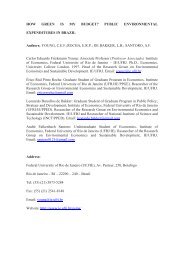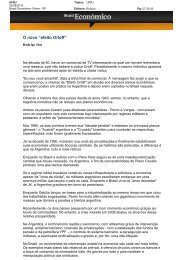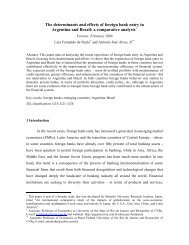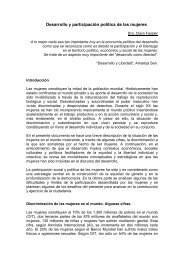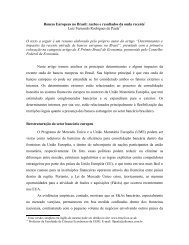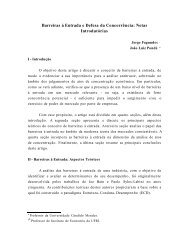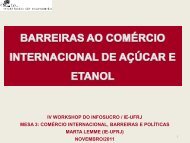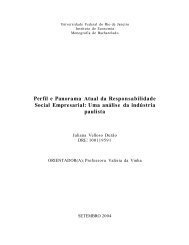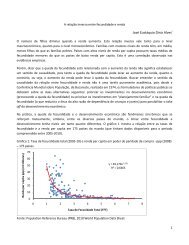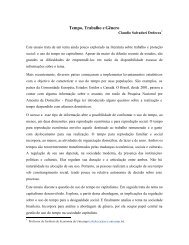Trade Integration for the Americas: What Can Economic Analysis ...
Trade Integration for the Americas: What Can Economic Analysis ...
Trade Integration for the Americas: What Can Economic Analysis ...
- No tags were found...
You also want an ePaper? Increase the reach of your titles
YUMPU automatically turns print PDFs into web optimized ePapers that Google loves.
111. <strong>What</strong> are <strong>the</strong> sector specific net welfare gains accruing to <strong>the</strong> country as a resultof adherence to <strong>the</strong> proposed RTA? <strong>What</strong> are <strong>the</strong> related production effects likelyto result from <strong>the</strong> RTA? Using partial equilibrium analysis, sector specificwelfare changes stemming from <strong>the</strong> RTA can be estimated. <strong>Trade</strong> creation anddiversion can be determined and quantified, along with changes in producersurplus, consumer surplus and tariff revenues. Significant sector knowledge andunderstanding – both in <strong>for</strong> <strong>the</strong> country in question and <strong>the</strong> prospective RTApartners – are required to model and quantitatively estimate <strong>the</strong>se changes. Pricecomparisons in <strong>the</strong> work are critical, implying much greater ease of analysis <strong>for</strong>more standardized products. In <strong>the</strong> case of a FTA with <strong>the</strong> US, <strong>the</strong> analysis shouldinvolve <strong>the</strong> use of domestic prices, US prices and international prices. The pricechanges associated with <strong>the</strong> FTA can be simulated along with <strong>the</strong>ir production,trade, consumption and revenue effects. 112. For those sectors where output and/or export expansion are anticipated as aresult of <strong>the</strong> RTA, is it likely that <strong>the</strong>re will be a supply response to ei<strong>the</strong>r <strong>the</strong>increased relative prices and a more competitive environment? <strong>What</strong> are <strong>the</strong>impediments to <strong>the</strong> sector’s supply response? A properly done sector should beable to identify such impediments, which may be caused by market imperfections,domestic regulation, institutional rigidities, or o<strong>the</strong>r market distortions.Recommendations as to how to deal with such impediments to market supplyresponse would be an important component <strong>for</strong> <strong>the</strong> envisaged sector studies.3. <strong>What</strong> are <strong>the</strong> sectoral employment effects likely to result from <strong>the</strong> RTA? WhileCGE simulation models can provide some notions of <strong>the</strong> employment effects,fur<strong>the</strong>r and more in-depth analysis may be necessary. CGE models are generallybased on perfect competition assumptions in labor markets, and also nodistinction is commonly made between labor – and skill – categories. In reality,<strong>the</strong>re may be considerable labor market rigidities or peculiarities which can not becaptured in more aggregative analyses. Since employment is of central concern toany government entering into a RTA, more in-depth analysis at <strong>the</strong> sector levelmay provide important insights <strong>for</strong> policy-makers.4. <strong>What</strong> are <strong>the</strong> implications of <strong>the</strong> RTA <strong>for</strong> market structure <strong>for</strong> <strong>the</strong> sector inquestion? And how might <strong>the</strong> existing market structure influence <strong>the</strong> outcome?Most manufactured and nontraditional service sectors are characterized byimperfect competition. Sector studies are necessary to examine <strong>the</strong> relationshipbetween market structure and trade. A RTA, <strong>for</strong> example, may make <strong>for</strong> a morecompetitive sector market and ei<strong>the</strong>r increase or diminish concentration. <strong>Analysis</strong>can be useful <strong>for</strong> policy <strong>for</strong>mulation.11 An illustrative case study is a sector study done recently by Gary Pursell <strong>for</strong> <strong>the</strong> Indian cement industry.See Gary Pursell, “Study of India-Bangladesh <strong>Trade</strong> and <strong>Trade</strong> Policies: Case Study Simulations of<strong>Economic</strong> Welfare Effects of a Free <strong>Trade</strong> Agreement,” World Bank working paper, December 2003.



